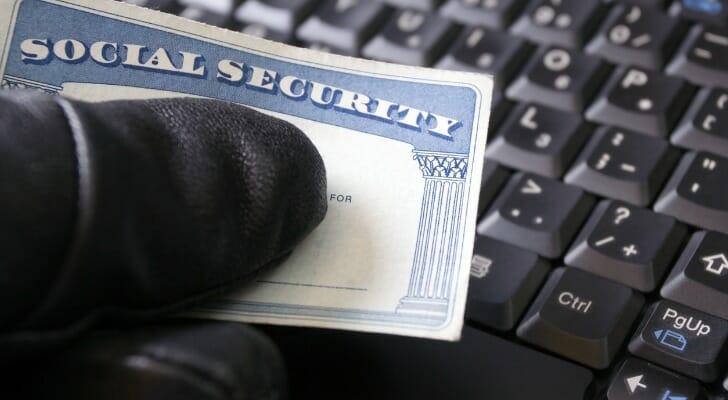Using Social Security’s Self Lock feature keeps anyone from using your Social Security number for credit or employment-related fraud. This prevents someone else’s wages from being reported to the Internal Revenue Services as your wages. However, it also will make it difficult or impossible to borrow money or get a new job. Self Lock automatically expires after a year or whenever you take action to cancel it.
A financial advisor can provide guidance on all matters financial, including identify protection.
Social Security Self Lock Basics
The Social Security Administration has a free, online tool called Self Lock that lets you immediately stop someone else from using your Social Security number when applying for a job or a new credit account. You can access this feature after setting up an account at Social Security’s E-Verity website.
Employers are required to withhold payroll taxes for Social Security and Medicare from employees’ paychecks. Employees provide Social Security numbers so the earnings and taxes will be attributed to the correct account. However, some job applicants, such as illegal immigrants, can’t get Social Security numbers. In order to work in the United States, they may provide false Social Security numbers to employers.
When that happens, it could mean their wages are being reported as your wages. Also, because Social Security numbers are widely used for identification by creditors, loans taken out by the person using the false Social Security number are likely to show up as belonging to the real owner of the number.
Self Lock eliminates these possibilities by locking the account number. An employer that contacts Social Security to verify the number will be told that it is a mismatch. Similarly, a creditor won’t be able to access a loan applicant’s credit report.
Benefits of Social Security Lock
By preventing fraudulent use of your number, Self Lock keeps someone else’s earnings from being reported as part of your employment record. The user of the false ID will have payroll taxes withheld, but won’t be able to later receive any Social Security benefits. The actual owner of the Social Security number will not get benefits from these taxes either. The taxes withheld go into the Social Security fund, but don’t activate any benefits for a specific worker.
Self Lock’s biggest benefit is that it stops someone from using a fraudulent number to apply for credit. It’s possible for someone using a fake Social Security number to get auto loans and mortgages and take on other obligations. This can create problems when the real owner of the Social Security number applies for credit.
Dealing with identity theft can be a stressful, time-consuming process that often takes months to resolve. A Social Security lock can help reduce that risk and the emotional toll that comes with it. Once the lock is in place, it effectively blocks any online or phone access to your account until you choose to unlock it. This can be especially valuable for individuals who don’t need frequent access to their Social Security information and prefer to keep their account sealed off from potential misuse.
The Social Security lock gives users more control over their personal information. Unlike older methods of fraud prevention that required contacting multiple agencies, locking your account is a simple, self-service action that can be reversed at any time. You can unlock it when you need to access your benefits or update details, then re-lock it afterward. This flexibility allows you to manage your digital security based on your personal comfort level and activity.
For individuals focused on retirement planning and wealth protection, the Social Security lock can complement other financial safeguards, such as credit freezes or fraud alerts. Because your Social Security number is a cornerstone of your financial identity, keeping it secure can help prevent issues that might affect your credit, tax filings or benefit eligibility. When used as part of a broader security strategy, this lock serves as a proactive step toward maintaining long-term financial stability.
Social Security Lock Drawbacks

Using Self Lock is a fairly extreme approach to identity protection and it has drawbacks. Social Security Self Lock keeps anyone, including employers and creditors, from verifying a Social Security number. This also means that if the real owner of the Social Security number supplies this number to a prospective employer, the employer will be told that the Social Security number does not match.
Similarly, a creditor such as a bank or credit card company uses a Social Security number to check the credit score of a loan applicant. If the number is locked, the creditor may not be able to access a prospective borrower’s score.
This can lead to a rejected loan application and make it difficult or impossible to get a new loan or a new job after you’ve activated Self Lock.
When Self Lock Makes Sense
Using the Social Security Self Lock can make sense if you’re concerned about someone trying to create a “my Social Security” account in your name. Identity thieves often use stolen personal data to open fraudulent accounts and redirect benefits. Activating a Self Lock prevents this by blocking anyone, even you, from setting up or accessing an online account until you remove the lock. This is especially important if you rarely log in to your account and want to ensure no one else can either.
If your personal information has been compromised in a data breach or you’ve already experienced identity theft, setting up a Self Lock can provide immediate protection. It effectively cuts off access to your Social Security record while you take other steps to secure your identity, such as freezing your credit or changing passwords. For victims of fraud, this temporary barrier can be a crucial measure to prevent further misuse of their Social Security number.
Alternatives to the Social Security Lock
You can do a lot to protect your personal identification without resorting to Self Lock. For instance, you can institute a credit freeze with credit reporting agencies. This requires contacting each individual agency, filling out some paperwork and paying a fee. This won’t stop Social Security employment fraud but will make it much harder for a thief to open a new credit account in your name because your credit score and report will be unavailable.
Another option is to place a fraud alert on your credit reports. Unlike a freeze, a fraud alert doesn’t block access to your credit file, but it requires lenders to verify your identity before opening new credit accounts. Fraud alerts are free and last one year, with extended versions available for confirmed identity theft victims. This approach adds an extra verification step without limiting your ability to apply for loans or credit cards when needed.
Good cybersecurity habits can also help protect your Social Security and financial data. Creating strong, unique passwords for your online accounts, enabling multi-factor authentication and monitoring your financial statements regularly are simple but powerful ways to reduce risk. Many cases of identity theft stem from weak digital security, so taking these precautions can be just as valuable as locking your Social Security record.
Bottom Line

Activating Social Security’s Self Lock feature will prevent anyone from using your Social Security number. This will make it harder for someone to fraudulently give your number when applying for a job or taking out a loan. With equivalent effectiveness, it will also stop you from borrowing money or getting a different job. You can release the Self Lock any time you want, and it lapses on its own after a year, but it probably only makes sense for people with a reason to think they may be extra-vulnerable to identify theft.
Credit Tips
- A financial advisor can help you make informed decisions about credit and other financial matters. Finding a financial advisor doesn’t have to be hard. SmartAsset’s free tool matches you with vetted financial advisors who serve your area, and you can have a free introductory call with your advisor matches to decide which one you feel is right for you. If you’re ready to find an advisor who can help you achieve your financial goals, get started now.
- One of the easiest and best ways to protect a Social Security number is to create a personal My Social Security account with the Social Security Administration at SSA.gov. Creating this account blocks anyone else from trying to create an account in your name. Even if they have your Social Security number, they won’t be able to create a fake account if you’ve already opened one.
Photo credit: ©iStock.com/blyjak, ©iStock.com/jacoblund, ©iStock.com/SDI Productions
